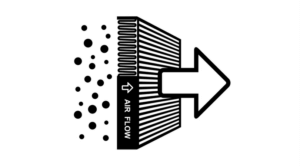How To Improve Indoor Air Quality
 The air in your home or business is dirty…no matter how much or how often you dust and clean. The Environmental Protection Agency notes that indoor air pollution ranks in the top five of environmental health risks. There are ways, however, to minimize exposure and decrease adverse health effects from indoor air pollutants.
The air in your home or business is dirty…no matter how much or how often you dust and clean. The Environmental Protection Agency notes that indoor air pollution ranks in the top five of environmental health risks. There are ways, however, to minimize exposure and decrease adverse health effects from indoor air pollutants.
Targeting Pollutants
Understanding what you want to accomplish in terms of targeting specific pollutants will help you make a decision about how to best approach purifying the air in a home or business. The different pollutants that affect air quality fall into two categories. The first is particulate matter like dust, molds, pet hair, bacteria and viruses. The second is gaseous pollutants like vapors that come from building materials, furnishings, and products such as adhesives, cleaning products, paints, and pesticides.
Many Choices and Ways of Attacking Pollutants
Once you’ve sorted out the pollutants you are aiming for, you can start weeding through the variety of devices and methods available and start weighing the potential investment options.
The primary choices for purifying air are whether to use portable, single-room air purifiers or install a whole-house air cleaner. This is assuming that a home is already operating on a central air system that uses some sort of filtration for basic home cooling and heating.
Simply upgrading the existing filters is relatively inexpensive way to trap more pollutants. Any trip to a retail outlet will provide numerous options for choosing filters with better efficiency and performance. Adding some sort of whole house air cleaner will involve installing equipment by a qualified technician or upgrading the existing filter system, but you will be able to target more pollutants and add to a home’s value by doing this.
Electrostatic Filtration
Taking it a step further than a simple filter upgrade, installing electrostatic filters in place of disposable filters will cost more than traditional fiberglass filters and will do a better job of collecting some particulate matter. But electrostatic filters do not capture larger particles and won’t capture odor or gaseous pollutants.
Extended Media Filters
Another way of using mechanical filtration is by using extended media filters These work similarly to flat panel filters in that they mechanically trap any particles that pass through them. These kinds of filters are 4- to 8-inches thick and look like an accordion of filtration media. These also require expert installation that can range in price upwards to $600. These filters need replacing every six months at a cost of about $50.
In-Duct Filtration
Moving up a notch in attacking indoor air pollution, adding an ultraviolet filter or other in-duct devices starts sending the cost from several hundreds of dollars to $1,000 or more. UV light does reduce biological components and some bacteria and viruses, but ultraviolet filters do not capture all pollutants. The ventilated air must still be filtered with conventional filtration; plus UV light does not necessarily eliminate smoke or other gaseous fumes.
Portable Air Purifiers
Upgrading filters or adding in-duct devices works well and provides a silent and usually unobtrusive component to the home. Portable air purifiers offer another option for purifying the air. Portable air purifiers can be used for homes without central air units or for cases where a localized issue might be of concern. They can be noisy and take up floor space. Most portable air purifiers do not effectively remove larger particles such as dust mites or pet hair in a large room. They can capture smoke, small airborne particles and pet dander and other particles in a localized space.
Last Words
This is only a cursory overview of the possibilities for addressing indoor air quality. Doing more homework and contacting a local, authorized HVAC company, like Temp Control, is recommended for a more thorough understanding of what needs and options might be best suited for your home or business.
Proud to use Coleman Equipment.
